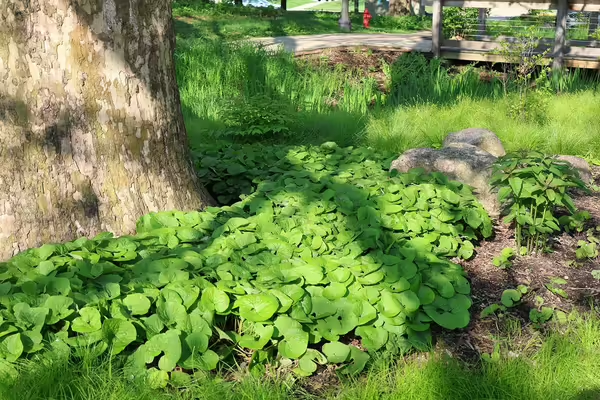
MATTOON, Ill. — The Lumpkin Family Foundation has awarded University of Illinois Extension a $40,000 grant to improve water quality and protect local drinking water sources in Coles County. The funding will support a Watershed Stewards community education program and the distribution of native plant kits.
In two separate incidents in July, the drinking water in Mattoon was unavailable when water samples tested positive for high levels of a neurotoxin produced by harmful algal blooms. Protecting source water, or the lakes and reservoirs that supply drinking water, is essential to prevent problems before water reaches the tap, which is more cost-effective. Water quality is a pressing environmental issue with many statewide challenges – including supply, pollution, and flooding – that require collective action.
The Lumpkin Family Foundation grant funds a two-part community initiative led by Water Quality and Stormwater Specialist Eliana Brown, with Illinois Extension and Illinois-Indiana Sea Grant. A Watershed Stewards program will launch in Coles County in early 2026, led by Extension Program Coordinator Jenny Lee. Anyone from the public can attend the program and learn about approaches to help protect local lakes. Participants will also have the opportunity to install native plants under native trees to slow stormwater runoff, benefit pollinators, and keep excess nutrients from entering local waterways. This “soft landings” concept was developed by Heather Holm and Leslie Pilgrim.
“Small efforts add up to cleaner water and healthier ecosystems,” said Brown. “Together, these can go a long way to reduce nutrient losses that fuel harmful algal blooms. Thanks to support from the Lumpkin Family Foundation, we’ll be engaging the Mattoon community with practices that help protect their drinking water supply.”
Launched statewide by Extension in 2024, the Watershed Stewards community training program equips and empowers people with science-based knowledge and resources to better understand, support, and protect their local water resources. Coles County is home to two major watersheds, the Embarras and the Little Wabash. Both have been identified as phosphorus-priority watersheds by the Illinois Nutrient Loss Reduction Strategy, and Brown noted that these new investments are a valuable contribution to existing water quality improvement efforts in the region. The runoff of the nutrients nitrogen and phosphorus into waterways is the main driver of harmful algal blooms, which is the excessive growth or “bloom” of some types of blue-green algae in waterways.
Everyone has a role in safeguarding local water quality long before it reaches treatment facilities. Homeowners and landscapers can apply nature-based solutions for stormwater management such as native plantings, trees, and rain gardens. Learn more at go.illinois.edu/RainfallManagement. Farmland owners can apply agricultural conservation practices that reduce nutrient loss, such as changing fertilization timing, reducing tilling, growing cover crops, and installing wetlands. Learn more at go.illinois.edu/NLR.
Across Illinois, Extension contributes to initiatives that improve water quality. Extension hosted the first northern Illinois Stormwater Leadership Summit in September. Since 2015, Extension has partnered with the Illinois EPA and Illinois Department of Agriculture to steer the Illinois Nutrient Loss Reduction Strategy. Local Extension staff are part of community watershed-based planning groups and coordinate water quality monitoring with Master Naturalist volunteers, and on campus, the Red Oak Rain Garden demonstrates rainfall management options. Illinois-Indiana Sea Grant helps strengthen and preserve aquatic ecosystems along the Lake Michigan shoreline.
More information
- City of Mattoon: Water Quality Response and Recovery Effort Report
- Illinois Extension: Nutrient Loss Reduction, Rainfall Management, Watershed Stewards
- Lumpkin Family Foundation
- North Central Region Water Network: Harmful Algal Bloom FAQs
Sources: Eliana Brown, Illinois Extension water quality and stormwater specialist; Jenny Lee, Illinois Extension Coles County program coordinator.
Photo: Growing native plants under native trees is a nature-based solution that can slow the movement of water during intense rainfall and filter out contaminants, mitigating floods and improving water quality. Photo by Madelyn Craft, University of Illinois Extension.
University of Illinois Extension develops educational programs, extends knowledge, and builds partnerships to support people, communities, and their environments as part of the state's land-grant institution. Extension serves as the leading public outreach effort for University of Illinois Urbana-Champaign and the College of Agricultural, Consumer and Environmental Sciences in all 102 Illinois counties through a network of 27 multi-county units and over 700 staff statewide. Extension’s mission is responsive to eight strategic priorities — community, economy, environment, food and agriculture, health, partnerships, technology and discovery, and workforce excellence — that are served through six program areas — 4-H youth development, agriculture and agribusiness, community and economic development, family and consumer science, integrated health disparities, and natural resources, environment, and energy.